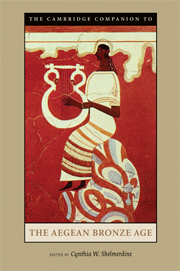Book contents
- Frontmatter
- 1 Background, Sources, and Methods
- 2 The Early Bronze Age in Greece
- 3 The Early Bronze Age in the Cyclades
- 4 Early Prepalatial Crete
- 5 Protopalatial Crete
- 6 The Material Culture of Neopalatial Crete
- 7 Minoan Culture: Religion, Burial Customs, and Administration
- 8 Minoan Crete and the Aegean Islands
- 9 Minoan Trade
- 10 Early Mycenaean Greece
- 11 Mycenaean Art and Architecture
- 12 Mycenaean States
- 13 Burial Customs and Religion
- 14 Mycenaean Greece, the Aegean and Beyond
- 15 Decline, Destruction, Aftermath
- Glossary
- Select Bibliography
- Index
- Plate section
10 - Early Mycenaean Greece
Published online by Cambridge University Press: 28 November 2010
- Frontmatter
- 1 Background, Sources, and Methods
- 2 The Early Bronze Age in Greece
- 3 The Early Bronze Age in the Cyclades
- 4 Early Prepalatial Crete
- 5 Protopalatial Crete
- 6 The Material Culture of Neopalatial Crete
- 7 Minoan Culture: Religion, Burial Customs, and Administration
- 8 Minoan Crete and the Aegean Islands
- 9 Minoan Trade
- 10 Early Mycenaean Greece
- 11 Mycenaean Art and Architecture
- 12 Mycenaean States
- 13 Burial Customs and Religion
- 14 Mycenaean Greece, the Aegean and Beyond
- 15 Decline, Destruction, Aftermath
- Glossary
- Select Bibliography
- Index
- Plate section
Summary
Chronological Phases
When the interregional culture of the Early Bronze Age in the Aegean collapsed, a period on the mainland of Greece followed that archaeologists term Middle Helladic (MH; Ch. 1, p. 3; Fig. 1.1). During much of this time the countryside was largely depopulated and there is very little evidence of trade and craft production. Because of the paucity of settlements discovered through excavation, only a few places have good stratified deposits: Lerna (level V), Kolonna on the island of Aegina (City VII-X), and Pefkakia in Thessaly.
Scholars during much of the twentieth century ce argued for a break between the Early and Middle Bronze Ages, theorizing in particular the arrival of Indo-European speaking peoples at this time. Research in the past thirty years, though, shows that despite destruction and abandonment of some settlements after EH II and EH III, the transition between these periods shows many signs of continuity (Ch. 2, pp. 36-7). Furthermore, the succeeding transition between EH III and MH I seems to have been less abrupt than previously thought, with evidence of continuity in some of the ceramics and lithic traditions at Lerna (Ch. 2, p. 41). Likewise, it was thought through the 1970s that the shaft graves at Mycenae announced a dramatic cultural change beginning in LH I (with some scholars even arguing that Indo-European Greek speakers arrived at this time), but this view no longer prevails. We often cannot distinguish MH III from LH I, and frequently refer to assemblages as MH III/LH I, because the society that was developing into what we commonly refer to as Mycenaean civilization had deep roots in the indigenous Middle Helladic cultural forms (Ch. 1, p. 3).
- Type
- Chapter
- Information
- The Cambridge Companion to the Aegean Bronze Age , pp. 230 - 257Publisher: Cambridge University PressPrint publication year: 2008
- 25
- Cited by

